2013德语二外期末试卷B卷及评分标准
- 格式:doc
- 大小:67.50 KB
- 文档页数:4
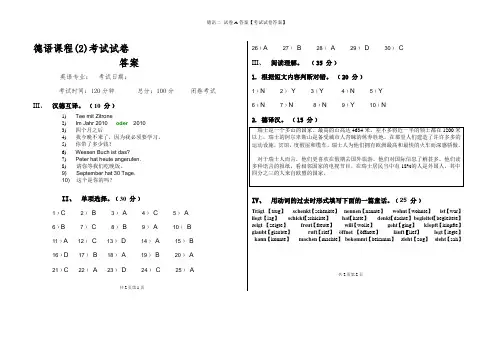
德语二试卷A答案【考试试卷答案】德语课程(2)考试试卷答案英语专业:考试日期:考试时间:120分钟总分:100分闭卷考试III、汉德互译。
﹙10 分﹚1)Tee mit Zitrone2)Im Jahr 2010 oder20103)四个月之后4)我今晚不来了,因为我必须要学习。
5)你带了多少钱?6)Wessen Buch ist das?7)Peter hat heute angerufen.8)请你等我们吃晚饭。
9) September hat 30 Tage.10) 这个是你的吗?II、单项选择。
﹙30 分﹚1﹚C2﹚B3﹚A4﹚C5﹚A6﹚B7﹚C8﹚B9﹚A10﹚B11﹚A12﹚C13﹚D14﹚A15﹚B16﹚D17﹚B18﹚A19﹚B20﹚A21﹚C22﹚A23﹚D24﹚C25﹚A共2页第1页26﹚A27﹚B28﹚A29﹚D30﹚CIII、阅读理解。
﹙35 分﹚1. 根据短文内容判断对错。
﹙20 分﹚1﹚N2﹚Y3﹚Y4﹚N5﹚Y6﹚N7﹚N8﹚N9﹚Y10﹚N2. 德译汉。
﹙15 分﹚IV、用动词的过去时形式填写下面的一篇童话。
﹙25 分﹚Trägt【trug】schenkt【schenkte】nennen【nannte】wohnt【wohnte】ist【war】liegt 【lag】schickt【schickte】hat【hatte】denkt【dachte】begleitet【begleitete】zeigt【zeigte】freut【freute】will【wolle】geht【ging】klopft【klopfte】glaubt【glaubte】ruft【rief】öffnet 【öffnete】läuft【lief】legt【legte】kann【konnte】machen【machte】bekommt【bekamm】zieht【zog】sieht【sah】共2页第2页。
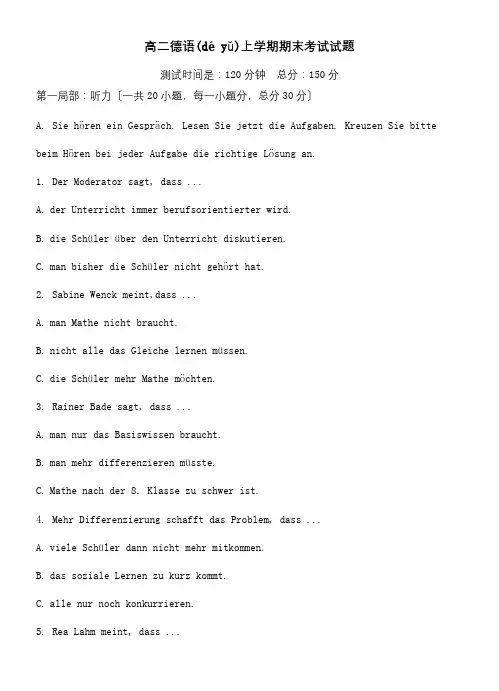
高二德语(dé yǔ)上学期期末考试试题测试时间是:120分钟总分:150分第一局部:听力〔一共20小题,每一小题分,总分30分〕A. Sie hören ein Gespräch. Lesen Sie jetzt die Aufgaben. Kreuzen Sie bitte beim Hören bei jeder Aufgabe die richtige Lösung an.1. Der Moderator sagt, dass ...A.der Unterricht immer berufsorientierter wird.B.die Schüler über den Unterricht diskutieren.C.man bisher die Schüler nicht gehört hat.2. Sabine Wenck meint,dass ...A.man Mathe nicht braucht.B.nicht alle das Gleiche lernen müssen.C.die Schüler mehr Mathe möchten.3. Rainer Bade sagt, dass ...A.man nur das Basiswissen braucht.B.man mehr differenzieren müsste.C.Mathe nach der 8. Klasse zu schwer ist.4. Mehr Differenzierung schafft das Problem, dass ...A.viele Schüler dann nicht mehr mitkommen.B.das soziale Lernen zu kurz kommt.C.alle nur noch konkurrieren.5. Rea Lahm meint, dass ...A.der Kunstunterricht oft zu theoretisch ist.B.sue immer viel Spaß im Kunstunterricht hatte.C.Fächer wie Kunst und Musik keine Schulfächer sind.6. Rainer Bade meint, eine Idee wäre, ...A.mehr Freizeit zu haben.B.dass man künsterische Aktivitäten außerhalb der Schule nachweisen muss.C.mehr kreative Fächer in der Schule zu haben.B. Sie hören gleich eine Radio-Reportage zum Thema “Glück〞. Lesen Sie jetzt die Aufgaben (7-14). Sie haben dafür zwei Minuten Zeit. Kreuzen Sie beim Hören bei jeder Aufgebe die richtige Lösung an. Sie hören den Text zweimal.7. Psychologen ...A.beschäftigen sich nicht mit dem Thema “Glück〞.B.sehen Glück als ein Freiheitsrecht.C.definieren Glück mit unterschiedlichen Begriffen.8. Laut einer Umfrage sind die größten Glücksfaktoren ...A.Gesundheit, Liebe, Partnerschaft und Kinder.B.Wohnsituation und beruflicher Erfolg.C.Geld und Besitz.9. Durch soziale Kontakte ...A.können viele Menschen ihre Stimmung verbessern.B.entstehen viele problematische Situationen.C.wird der Alltag leichter.10. Glücklich zu sein ist für die Deutschen ...A.immer wichtiger geworden.B.eine egoistische Lebenseinstellung.C.schon immer das wichtigste Lebensziel gewesen.11. Die Deutschen denken, dass ...A.Glück Schicksal ist.B.man Glück beeinfluss en kann.C.Glück genetisch bedingt ist.12. Nicht so zufrieden sind Menschen, die ...A.sich politisch und sozial engagieren.B.materiellen Wohlstand anstreben.C.religiös sind13.Religiöse Meschen ...A.streben nicht nach Glück im LebenB.fühlen sich im Durchschnitt bes ser als andere.C.sind je nach Reliogion unterschiedlich glücklich14.Die Reportage berichtet über ...A.Möglichkeiten, ein glückliches Leben zu führen.B.Untersuchungen zum Thema “Glück〞.C.verschiedene Definitionen von Glück.C. Hören Sie den Dialog und markieren S ie, Welche Aussage richtig oder falsch sind.第二局部德语(dé yǔ)知识运用〔一共两节,满分是45分〕第一节单项琪空(一共15小题:每一小题1分,满分是15分)21.Meine Eltern betrachten mich immer kleines Kind.A.fürB. gegenC. alsD. an22.Jugendliche sind sich der Probleme der Gesellschaft bewusst..A.auf hoher MaßeB. in hoher MaßeC. auf hohem MaßeD. in hohem Maße23.Die müssen Verantwortung übernehmen.A.verschuldeten JugendlichenB. verschuldete JugendlicheB.verschuldeten Jugendliche B. verschuldete Jugendlichen24. Die Broschüre informiert über Tierarten.A.die vom Aussterben bedrohendenB. die vom Aussterben bedrohtenC. die vom Aussterben bedrohendeD. die vom Aussterben bedrohte25. Die schwüle Hitze bei uns ist an manchen Tagen kaum .A.aufzubrauchenB. herzuziehnC. auszuhaltenD. anzuhalten26.Soll man der Jugendsprache Grenzen .A.setzenB. ersetzenC. versetzenD. aussetzen27. dem Jugendschutzgesetz ist es Jugendlichen unter 16 Jahren untersagt, in die Disco zu gehen.A.AnB. NachC. WegenD. Trotz28. meine Mutter in den Urlaub gefahren ist, musste mein Vater zu Hause bleiben, um sich um meine Oma zu kümmern.A.WennB. SolangeC. SobaldD. Während29.Der Film “少年(shàonián)的你〞 spricht die meistenJugendlichen .A.überB. anC. vorD. nach30.Die lange Zeit zur Arbeit in Beijing ist mit Staus .A.zu erklärenB. aufzuklärenB.zu klären D. zu verklären31.Das Buch wendet an alle Germanistikstudenten.A.sichB. michC. dichD. /32.Manchmal woll en sich die Senioren ständig in die Angelegenheiten derJüngeren .A.einmischenB. mischenC. vermischenD. bemischen33.Franz ist krank, er .A.hat sich überarbeiten könnenB. könnte sich überarbeitet habenC. hätte sich überarbeiten könnenD. hätte sich überarbeitet können34.Anna arbeitet täglich bis zu 12 Stunden, sich zu beklagen.A.stattB. ohnetC. umD. /35.Die Selbstständigkeit ist zweifelsohne großer Bedeutung.A. a ufB. anC. vonD. für第二节完形填空〔一共(yīgòng)20小题;每一小题分,满分是30分〕第三节阅读下面短文,从短文后各题所给的四个选项(A, B, C和D)中,选出可以填入空白处的最正确选项。
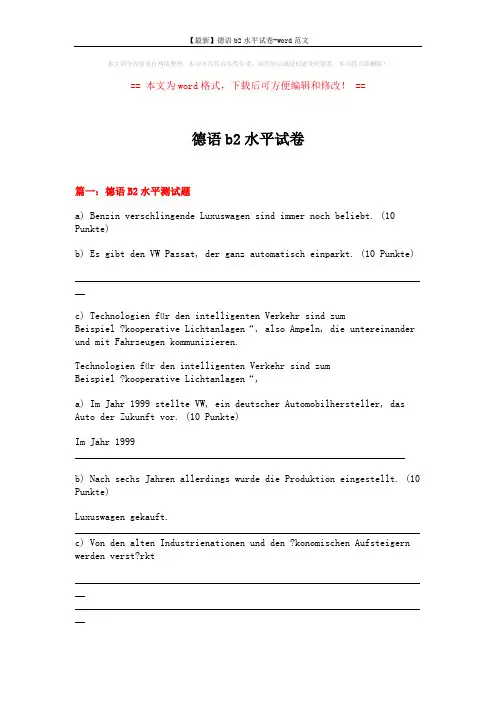
本文部分内容来自网络整理,本司不为其真实性负责,如有异议或侵权请及时联系,本司将立即删除!== 本文为word格式,下载后可方便编辑和修改! ==德语b2水平试卷篇一:德语B2水平测试题a) Benzin verschlingende Luxuswagen sind immer noch beliebt. (10 Punkte)b) Es gibt den VW Passat, der ganz automatisch einparkt. (10 Punkte)_____________________________________________________________________ __c) Technologien für den intelligenten Verkehr sind zumBeispiel ?kooperative Lichtanlagen“, also Ampeln, die untereinander und mit Fahrzeugen kommunizieren.Technologien für den intelligenten Verkehr sind zumBeispiel ?kooperative Lichtanlagen“,a) Im Jahr 1999 stellte VW, ein deutscher Automobilhersteller, das Auto der Zukunft vor. (10 Punkte)Im Jahr 1999__________________________________________________________________b) Nach sechs Jahren allerdings wurde die Produktion eingestellt. (10 Punkte)Luxuswagen gekauft._____________________________________________________________________ c) Von den alten Industrienationen und den ?konomischen Aufsteigern werden verst?rkt_____________________________________________________________________ _______________________________________________________________________ __a) Erfahrungen zeigen, dass der Kauf eines Autos nicht davon abh?ngt, ob es das ?kologische Gewissen entlastet.Erfahrungen zeigen, dass der Kauf eines Autos nicht_____________________________________________________________________ __b) So fahren Amerikaner trotz der ansteigenden Benzinkosten entgegen aller ?kologischer und ?konomischer Einsicht noch immer tonnenschwere Gel?ndewagen.So fahren Amerikaner_____________________________________________________________________c) Japanische Autos machen eine Vollbremsung, weil sie den Zusammensto? berechnen. (10 Punkte)Japanische Autos______________________________________________________________a) Der Autoentwickler kann auch einfach die zu transportierende Masse reduzieren, das hei?t leichtere Materialien entwickeln._____________________________________________________________________ __L?SUNGENa) a) Benzin verschlingende Luxuswagen sind immer noch beliebt. (10 Punkte)Luxuswagen (1), die (4) Benzin verschlingen (4), sind immer noch beliebt (1).b) Es gibt den VW Passat, der ganz automatisch einparkt. (10 Punkte) Es gibtden ganz automatisch (2) einparkenden (8) VW Passat.c) Technologien für den intelligenten Verkehr sind zumBeispiel ?kooperative Lichtanlagen“, also Ampeln, die untereinander und mit Fahrzeugen kommunizieren. (10 Punkte)Technologien für den intelligenten Verke hr sind zum Beispiel ?kooperative Lichtanlagen“,also untereinander und mit Fahrzeugen (1) kommunizierende (8) Ampeln (1).a) Im Jahr 1999 stellte VW, ein deutscher Automobilhersteller, das Auto der Zukunft vor. (10 Punkte) Im Jahr 1999 wurde( 4) von (1) VW, einem (1) deutschen (1) Automobilhersteller, das Auto der Zukunft vorgestellt (3).b) Nach sechs Jahren allerdings wurde die Produktion eingestellt. (10 Punkte)Nach sechs Jahren hat (4) man (4) die Produktion allerdings eingestellt (2).c) Von den alten Industrienationen und den ?konomischen Aufsteigern werden verst?rkt Luxuswagen gekauft. (10 Punkte) Die (2) alten Industrienationen (1) und die (2) ?konomischen Aufsteiger (1) kaufen (4) verst?rktLuxuswagen.a) Erfahrungen zeigen, dass der Kauf eines Autos nicht davon abh?ngt, ob es das ?kologische Gewissen entlastet. (10 Punkte) Erfahrungen zeigen, dass der Kauf eines Autos nicht von (1) der Entlastung (6) des ?kologischenGewissens (3) abh?ngt.b) So fahren Amerikaner trotz der ansteigenden Benzinkosten entgegen aller ?kologischer und?konomischer Einsicht noch immer tonnenschwere Gel?ndewagen. (10 Punkte) So fahren Amerikaner entgegen aller ?kologischerund ?konomischer Einsicht noch immertonnenschwere Gel?ndewagen, obwohl (7) die (1) Benzinkosten ansteigen (2).c) Japanische Autos machen eine Vollbremsung, weil sie den Zusammensto? berechnen. (10 Punkte) Japanische Autos machen aufgrund (5) der (einer) (1) Berechnung (2) des (1) Zusammensto?es (1) eine Vollbremsung.a) Der Autoentwickler kann auch einfach die zu transportierende Masse reduzieren, das hei?t leichtere Materialien entwickeln. (10 Punkte) Es ist m?glich (5), dass (1) der Autoentwickler auch einfach die zutransportierende Masse reduziert (2), das hei?t, leichtere Materialien entwickelt (2).Das Auto der ZukunftIm Jahr 1999 stellte VW, ein gro?er deutscher Automobihersteller, das Auto derDas Auto der ZukunftIm Jahr 1999 stellte VW, ein gro?er deutscher Automobilhersteller, das Auto der Zukunft vor: Den’Lupo’ mit seie leichten Bauweis e, innovativen Materialien, hervorragender Aerodynamik - und einem Verbrauch von drei Litern Diesel auf 100 Kilometer. Nach sechs Jahren allerdings wurde die Produktion eingestellt.Die bittere Lehre für VW: Das Auto der Zukunft kann noch so tolle Werte haben, kann das ?kologische Gewissen entlasten und beim Tanken jedes Mal das Herz erfreuen. Wenn es sich nach Verzicht und Defizit anfühlt, wenn es den Spa? bremst und die Fahrfreunde verdirbt, wird es nicht gekauft. Der Lupo hatte dünne Energiesparreifen, nur 2 Türen und einen kleinen Kofferraum, war innen eng und infolge des Leichtbaus fahrdynamisch problematisch. Ein sensationell niedriger Verbrauch stellte sich nur bei komplett leidenschaftsloser Fahrweise ein. Es war eben ein Vernunftauto.Umweltfreundliche Autos haben es schwer, Benzin verschlingende Luxuswagen sind immer noch beliebt. Was aber wird in zehn oder zwanzig Jahren über unsere Stra?en rollen? Im Folgenden finden Sie sieben Thesen zu dem Auto der Zukunft:These 1:Auch das Auto der Zukunft wird kein Vernunftauto sein. Autofahren hat wenig bis gar nichts mit Vernunft zu tun. So fahren Amerikaner trotz des hohen Benzinverbrauchs und der enormen Emissionen entgegenaller ?kologischer und ?konomischer Einsicht noch immertonnenschwere Gel?ndewagen. Und sparsame Dieselmotoren m?gen nurMinderheiten, sparsame Autos verkaufen sich schlecht.25 These 2: Das Auto der Zukunft wird es nicht geben. Stattdessen wird es drei sehr unterschiedliche Grundtypen geben: Billigautos werden noch viel wichtiger und erfolgreicher sein. Die alten。
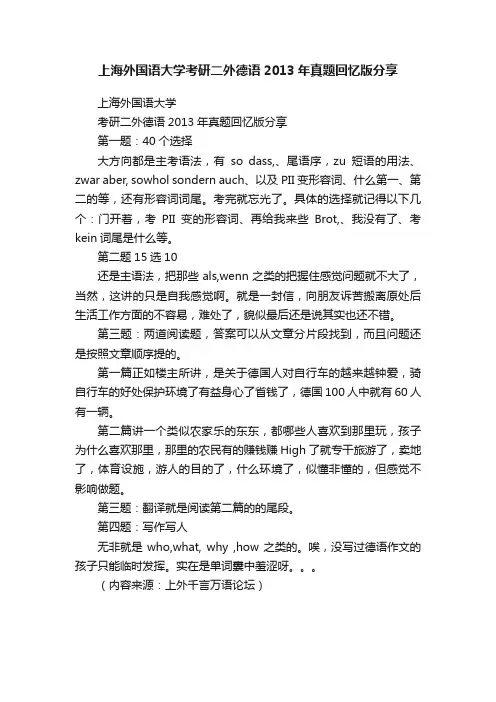
上海外国语大学考研二外德语2013年真题回忆版分享
上海外国语大学
考研二外德语2013年真题回忆版分享
第一题:40个选择
大方向都是主考语法,有so dass,、尾语序,zu短语的用法、zwar aber, sowhol sondern auch、以及PII变形容词、什么第一、第二的等,还有形容词词尾。
考完就忘光了。
具体的选择就记得以下几个:门开着,考PII变的形容词、再给我来些Brot,、我没有了、考kein词尾是什么等。
第二题15选10
还是主语法,把那些als,wenn之类的把握住感觉问题就不大了,当然,这讲的只是自我感觉啊。
就是一封信,向朋友诉苦搬离原处后生活工作方面的不容易,难处了,貌似最后还是说其实也还不错。
第三题:两道阅读题,答案可以从文章分片段找到,而且问题还是按照文章顺序提的。
第一篇正如楼主所讲,是关于德国人对自行车的越来越钟爱,骑自行车的好处保护环境了有益身心了省钱了,德国100人中就有60人有一辆。
第二篇讲一个类似农家乐的东东,都哪些人喜欢到那里玩,孩子为什么喜欢那里,那里的农民有的赚钱赚High了就专干旅游了,卖地了,体育设施,游人的目的了,什么环境了,似懂非懂的,但感觉不影响做题。
第三题:翻译就是阅读第二篇的的尾段。
第四题:写作写人
无非就是who,what, why ,how之类的。
唉,没写过德语作文的孩子只能临时发挥。
实在是单词囊中羞涩呀。
(内容来源:上外千言万语论坛)。
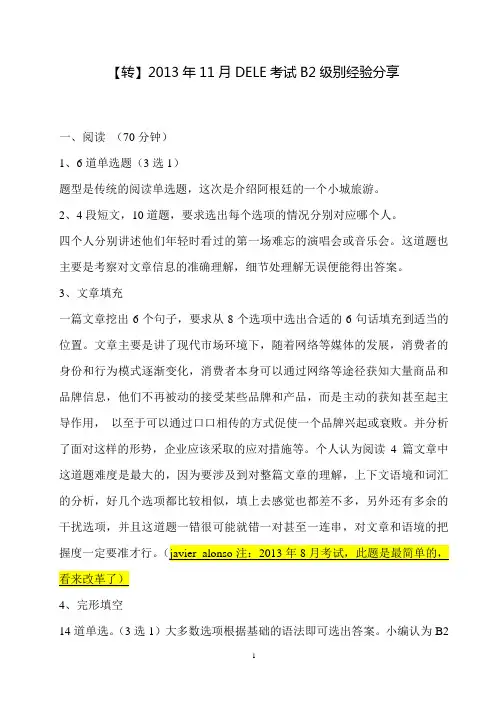
【转】2013年11月DELE考试B2级别经验分享一、阅读(70分钟)1、6道单选题(3选1)题型是传统的阅读单选题,这次是介绍阿根廷的一个小城旅游。
2、4段短文,10道题,要求选出每个选项的情况分别对应哪个人。
四个人分别讲述他们年轻时看过的第一场难忘的演唱会或音乐会。
这道题也主要是考察对文章信息的准确理解,细节处理解无误便能得出答案。
3、文章填充一篇文章挖出6个句子,要求从8个选项中选出合适的6句话填充到适当的位置。
文章主要是讲了现代市场环境下,随着网络等媒体的发展,消费者的身份和行为模式逐渐变化,消费者本身可以通过网络等途径获知大量商品和品牌信息,他们不再被动的接受某些品牌和产品,而是主动的获知甚至起主导作用,以至于可以通过口口相传的方式促使一个品牌兴起或衰败。
并分析了面对这样的形势,企业应该采取的应对措施等。
个人认为阅读4篇文章中这道题难度是最大的,因为要涉及到对整篇文章的理解,上下文语境和词汇的分析,好几个选项都比较相似,填上去感觉也都差不多,另外还有多余的干扰选项,并且这道题一错很可能就错一对甚至一连串,对文章和语境的把握度一定要准才行。
(javier alonso注:2013年8月考试,此题是最简单的,看来改革了)4、完形填空14道单选。
(3选1)大多数选项根据基础的语法即可选出答案。
小编认为B2新题型取消了“词汇和语法”(Gramática y vocabulario)以后,这一内容实际上是部分移植到阅读的完型部分以及作文里了。
(javier alonso注:此题尽量拿满分,对于提高阅读和写作的总分数有帮助)二、听力(40分钟)1、短对话(3选1)6段短对话,听两遍,主要是生活、学习、工作等场景,和传统的听力考试题型差不多,难度不是很大,关键是集中注意力,心态不要紧张,提前看题熟悉会话内容很重要。
2、长对话1段两个人之间的对话,6道题,听2遍,要求选出每个描述分别对应哪个人,或者两个人都不是。
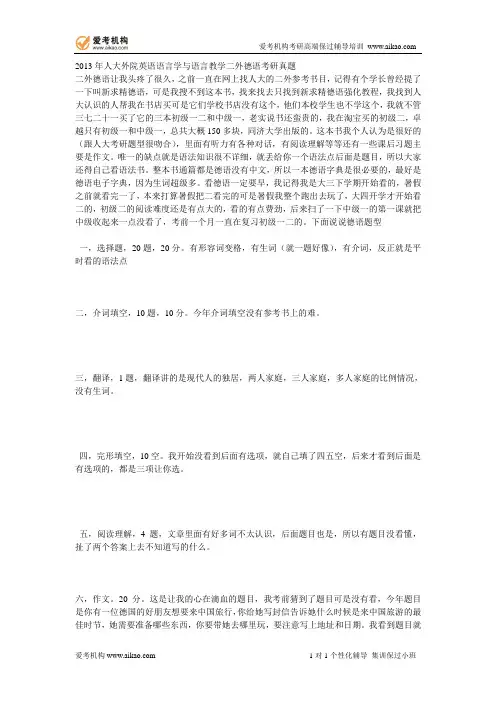
2013年人大外院英语语言学与语言教学二外德语考研真题二外德语让我头疼了很久,之前一直在网上找人大的二外参考书目,记得有个学长曾经提了一下叫新求精德语,可是我搜不到这本书,找来找去只找到新求精德语强化教程,我找到人大认识的人帮我在书店买可是它们学校书店没有这个,他们本校学生也不学这个,我就不管三七二十一买了它的三本初级一二和中级一,老实说书还蛮贵的,我在淘宝买的初级二,卓越只有初级一和中级一,总共大概150多块,同济大学出版的。
这本书我个人认为是很好的(跟人大考研题型很吻合),里面有听力有各种对话,有阅读理解等等还有一些课后习题主要是作文。
唯一的缺点就是语法知识很不详细,就丢给你一个语法点后面是题目,所以大家还得自己看语法书。
整本书通篇都是德语没有中文,所以一本德语字典是很必要的,最好是德语电子字典,因为生词超级多。
看德语一定要早,我记得我是大三下学期开始看的,暑假之前就看完一了,本来打算暑假把二看完的可是暑假我整个跑出去玩了,大四开学才开始看二的,初级二的阅读难度还是有点大的,看的有点费劲,后来扫了一下中级一的第一课就把中级收起来一点没看了,考前一个月一直在复习初级一二的。
下面说说德语题型一,选择题,20题,20分。
有形容词变格,有生词(就一题好像),有介词,反正就是平时看的语法点二,介词填空,10题,10分。
今年介词填空没有参考书上的难。
三,翻译,1题,翻译讲的是现代人的独居,两人家庭,三人家庭,多人家庭的比例情况,没有生词。
四,完形填空,10空。
我开始没看到后面有选项,就自己填了四五空,后来才看到后面是有选项的,都是三项让你选。
五,阅读理解,4题,文章里面有好多词不太认识,后面题目也是,所以有题目没看懂,扯了两个答案上去不知道写的什么。
六,作文。
20分。
这是让我的心在滴血的题目,我考前猜到了题目可是没有看,今年题目是你有一位德国的好朋友想要来中国旅行,你给她写封信告诉她什么时候是来中国旅游的最佳时节,她需要准备哪些东西,你要带她去哪里玩,要注意写上地址和日期。
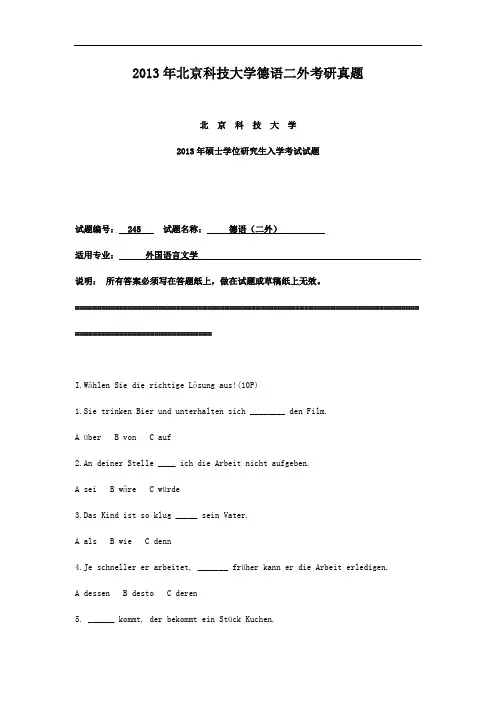
2013年北京科技大学德语二外考研真题北京科技大学2013年硕士学位研究生入学考试试题试题编号: 245 试题名称:德语(二外)适用专业:外国语言文学说明:所有答案必须写在答题纸上,做在试题或草稿纸上无效。
============================================================================== ===============================I.Wählen Sie die richtige Lösung aus!(10P)1.Sie trinken Bier und unterhalten sich ________ den Film.A überB vonC auf2.An deiner Stelle ____ ich die Arbeit nicht aufgeben.A seiB wäreC würde3.Das Kind ist so klug _____ sein Vater.A alsB wieC denn4.Je schneller er arbeitet, _______ früher kann er die Arbeit erledigen.A dessenB destoC deren5. ______ kommt, der bekommt ein Stück Kuchen.A WerB WemC Wen6. Sie hat sc hön_ Blumen gekauft.A erB enC e7. Es wird immer ________ im Herbst.A kaltB kalterC kälter8. Sie wünscht________________________.A zu reisen nach EuropaB nach Europa zu reisenC nach Europa reisen zu9. Weil die Hose ______ sehr gefällt, k auft sie sie.A sieB ihnC ihr10. Was für _______ Mensch ist er?A einenB einC einemII. Ergänzen Sie die passenden Wörter!(10P)1. Soll ich ______ etwas Besonderes aufpassen?2. Können Sie mir _______, wo das Goethe-Institut ist?3. Er möchte ein Konto _________ und geht in die Bank.4. Sie ist bei Familie Schneider zum Abendessen ___________.5. Am Wochenende machen sie entweder einen Ausflug _____ bleiben zu Hause.6. Morgen gegen 8 Uhr hole ich dich ___. Dann fahren wir los.7. Fußball gehört _____ den populärsten Sportarten der Welt.8. Er geht auf die Party, _______ niemand ihn einlädt.9. _____ viel Licht ist, da ist viel Schatten.10. Kauflust hängt stark ____ der Auswahl ab, die dem Kunden geboten wird.III. Bilden Sie Sätze! Jeder Satz soll mindestens acht Wörter enthalten!(20P)1. fragen2. schreiben3. schlafen4. feiern5. wünschen6. sich verabschieden7. suchen8. beschäftigen9. tragen10.denkenIV. Übersetzen Sie die folgenden Sätze ins Deutsche!(20P)1.这位年轻的教授很受外国学生的欢迎。
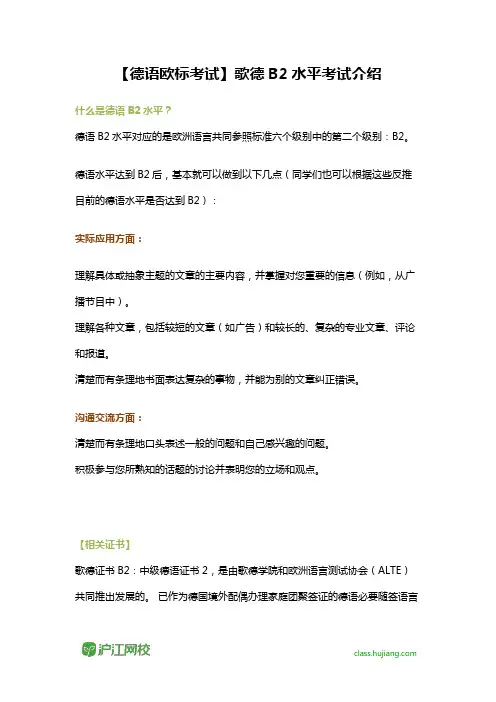
【德语欧标考试】歌德B2水平考试介绍什么是德语B2水平?德语B2水平对应的是欧洲语言共同参照标准六个级别中的第二个级别:B2。
德语水平达到B2后,基本就可以做到以下几点(同学们也可以根据这些反推目前的德语水平是否达到B2):实际应用方面:理解具体或抽象主题的文章的主要内容,并掌握对您重要的信息(例如,从广播节目中)。
理解各种文章,包括较短的文章(如广告)和较长的、复杂的专业文章、评论和报道。
清楚而有条理地书面表达复杂的事物,并能为别的文章纠正错误。
沟通交流方面:清楚而有条理地口头表述一般的问题和自己感兴趣的问题。
积极参与您所熟知的话题的讨论并表明您的立场和观点。
【相关证书】歌德证书B2:中级德语证书2,是由歌德学院和欧洲语言测试协会(ALTE)共同推出发展的。
已作为德国境外配偶办理家庭团聚签证的德语必要随签语言证明。
从2007年7月起实施的新移民法中(也包括在家庭团聚签证的签证申请程序中),歌德语言证书(A 1 至C 2)都作为德语语言证明而被承认。
【Achtung】歌德证书B2被许多国家作为德语语言文学专业的入学条件。
【考试介绍】B2考试分成个板块:笔试及口试笔试分三格科目:口试为双人考试例外情况也可以单人考试双人考试15分钟,单人考试10分钟。
无论单人或双人考试,考生口试准备时间皆为15分钟。
【考试评分】总分为100分:笔试为75分,口试为25分。
每一科总分25分,计算总分时将每项得分加总,小数不做任何四舍五入。
【Achtung】参加所有考试科目,且至少获得60分。
其中笔试至少45分,口试至少15分,视为及格。
否则考试视为不及格整个考试的分数及评等如下:学德语 有沪江就够了!让你足不出户轻松学习地道德语——让兴趣成为你的竞争力沪江德语诞生于2011年,发展至今,培训学员已逾数万名; 完备的德语课程体系,入门、进阶、高阶、考试,全方位满足学习需求; 强大的师资团队,授课教师具有名校或海归背景; 贴心的助教服务,24小时内为您解决任何德语学习问题;在沪江报班后怎么学:________________________________________________________________________ 更多德语课程,点击德语咨询顾问老师>>制定专属你的学习方案上沪江,更有各级别德语课程免费试听>>。
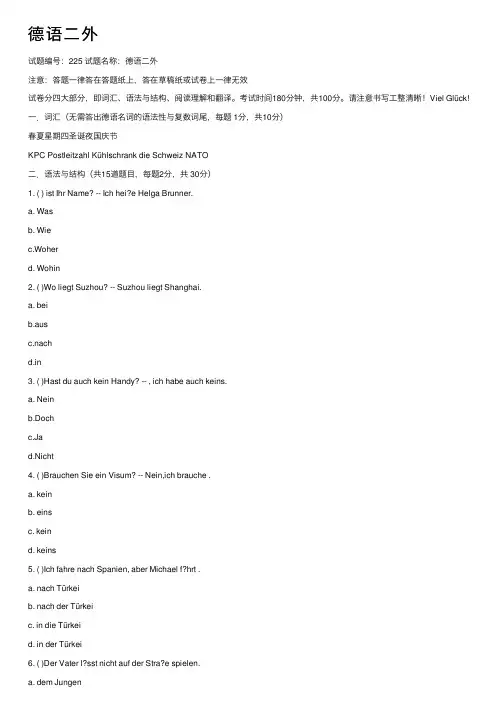
德语⼆外试题编号:225 试题名称:德语⼆外注意:答题⼀律答在答题纸上,答在草稿纸或试卷上⼀律⽆效试卷分四⼤部分,即词汇、语法与结构、阅读理解和翻译。
考试时间180分钟,共100分。
请注意书写⼯整清晰!Viel Glück!⼀.词汇(⽆需答出德语名词的语法性与复数词尾,每题 1分,共10分)春夏星期四圣诞夜国庆节KPC Postleitzahl Kühlschrank die Schweiz NATO⼆.语法与结构(共15道题⽬,每题2分,共 30分)1. ( ) ist Ihr Name? -- Ich hei?e Helga Brunner.a. Wasb. Wiec.Woherd. Wohin2. ( )Wo liegt Suzhou? -- Suzhou liegt Shanghai.a. beib.ausc.nachd.in3. ( )Hast du auch kein Handy? -- , ich habe auch keins.a. Neinb.Dochc.Jad.Nicht4. ( )Brauchen Sie ein Visum? -- Nein,ich brauche .a. keinb. einsc. keind. keins5. ( )Ich fahre nach Spanien, aber Michael f?hrt .a. nach Türkeib. nach der Türkeic. in die Türkeid. in der Türkei6. ( )Der Vater l?sst nicht auf der Stra?e spielen.a. dem Jungenc. seinen Jungend. den Junge7. ( )Geld ist nicht alles, ohne Geld kann alles nicht.a. undb. dennc. oderd. aber8. ( )Wann sind Sie hierher gekommen? -- einem Monat.a. Seitb. Nachc. V ord. In9. ( )Christa dem Rat ihrer Klassenlehrerin gefolgt.a. hatb. istc. sindd. haben10. ( )Die Schmerzen sind furchtbar, Herr Doctor! Ich kann sie nicht mehr .a. erhaltenb. anhaltenc. aushaltend.behalten11. ( )Zum Geburtstag wünsche ich dir alles .a. gutb. gutec. Guted. Gutes12. ( )Das Zimmer kostet 175 Euro.a. meistenb. sp?testensc. mindestensd. mehr13. ( )Kommen Sie aus Italien, Herr Baumann? -- Nein, ich bin .a. deutschc. Deutscherd. Deutsch14. ( )China ist der gr??ten L?nder in der Welt.a. einb. einsc.das eined. das gr??te15. ( )Heute Abend gibt es ein Fu?ballspiel im Fernsehen. Hast du Lust ?a. dazub. damitc. dafürd. darüber三.阅读理解(Text A 有8道题⽬,Text B 有5道题⽬,每篇各20分,共 40分)Text A 20分Fernsehen oder lieber lesen?Verdr?ngt das Fernsehen die Bücher? Dieser Frage wollten wir auf den Grund gehen. Deshalb zogen wir mit Frageb?gen durch unsere Schule und interviewten 90 Mitschüler und Mitschülerinnen im Alter von 12 bis 18 Jahren.42 Prozent der von uns Befragten empfanden das Lesen als zu anstrengend. Eine Bibliothekarin erkl?rte dazu, dass Jugendliche im Alter von 12 bis 16 Jahren ihrer Erfahrung nach am wenigsten lesen würden. Au?erdem konnte festgestellt werden, dass M?dchen zwischen 12 und 18 Jahren mehr lesen als Jungen. Diese Aussagen wurden uns von einer Bibliothekarin und einer Buchh?ndlerin best?tigt.Was interessiert denn nun jugendliche Leser? 47,5 Prozent lesen über Probleme von Jugendlichen. Lieblingsbücher der jungen Leute sind zur Zeit unter anderem Stephen Kings …Es“ und Joanne K. Rowlings …Harry Potter“. Au?erdem sind die Geschichten …Momo“ und …Die unendliche Geschichte“ von Michael Ende sehr gefragt. Der Bere ich der Fantasy ist bei den Schülern und Schülerinnen am beliebtesten.Das Fernsehen ist nach unserer Umfrage die gr??te Konkurrenz für das Buch. …Fernsehen ist wesentlich einfacher zu konsumieren als Bücher!“ sagte ein 17-j?hriges M?dchen. Viele schlie?en sich ihrer Meinug an, doch einige ?u?erten sich auch anders. Einer von ihnen sagte: …Fernsehen und Lesen sind zwei verschiedene Paar Schuhe! Das kann man nicht miteinander vergleichen!“Das Ergebnis war für uns eindeutig. Das Lesen wird vom Fernsehen immer mehr in den Hintergrund gedr?ngt. Die Jugendlichen wünschen sich immer modernere Ger?te. Sie müssen sich also kaum noch anstrengen, um an Informationen zu gelangen.Zus?tzlich ist es einfacher, da Situationen in Bildern und mit Bewegung dargestellt werden. Obwohl viele Jugendliche noch immer gern lesen, wird oftmals der Fernseher einem spannenden Buch vorgezogen.Richtig oder falsch?1. ( ) Bei der Umfrage wurden 12- bis 18-J?hrige mehrerer Schulen befragt.2. ( ) Die meisten Befragten finden das Lesen zu mühsam.3. ( ) Jugendliche im Alter von 12 bis 16 Jahren lesen weniger als die anderen.4. ( ) M?dchen im Alter von 12 bis 18 lesen mehr als die gleichaltrige Jungen.5. ( ) Die Schüler und Schülerinnen lesen am liebsten Liebesgeschichten.6. ( ) Viele der Befragten meinen, dass Fernsehen interessanter als Lesen ist.7. ( ) Wegen des Fernsehens wird unter den Jugendlichen immer wenigergelesen8. ( ) Wenn man nicht liest, kann man kaum Informationen bekommen.Text B 20分NaturkatastrophenSchwere Naturkatastophen haben seit 1990 weltweit Sch?den in Milliardenh?he verursacht und auch die Bilanzen der Versicherungen zerst?rt. Hurrikan Andrew sorgte in den USA 1994 allein für Versicherungssch?den von rund 40 Milliarden Mark, sagt ein Experte der Münchener Rückversicherung. Aber auch das Oder-Hochwasser 1997 und die Herbststürme in Europa 1990 verhagelten einigen Versicherungen die Gewinne.Die Ver?nderung des Klimas und die dadurch steigende Zahl von überschwemmungen und Stürmen k?nnte für die Versicherer sehr teuer werden, rechnet Gerhard Berz vor: Durch den Treibhauseffekt und weitere Klimasch?den würden die Ansprüche Jahr für Jahr zunehmen, meint der meteorologe der Münchener Rückversicherungs-Gesellschaft AG, einer der gr??ten Versicherung für Versicherungen.Seit 1990 kam es seinen Angaben nach weltweit bereits zu 18 Katastrophen, die mehr als eine Milliarde DM Versicherungssch?den verursachten. Er führt diesen Trend auf die Klimasch?den zurück. Wenn die Branche nicht gemeinsam mit Politik und Wirtschaft Konzepte gegen die Klimaver?nderungen entwickle, würde es nicht nur immerVerwüstungen geben. Die gesamte Versicherungswirtschaft k?nnte in ihrer Existenz bedroht werden, sagt Berz.Nach den Herbststürmen in Europa 1990 h?tten die Versicherer rund zehn Milliarden US Dollar zahlen müssen. Durchschnittlich h?tten die Sch?den aber gerade mal 1000 DM betragen, sagt Berz. Abgerissene Antennen, weggewehte Dachziegel oder zerschlagene Blument?pfe machten den gr??ten Teil der Ansprüche aus. Nach Auffassung der Versicherer sollten die Gesch?digten künftig selbst für solche Summen aufkommen.Bereits kleine Ver?nderungen des Weltklimas würden inzwischen furchtbare Sch?den anrichten, sagt Klilmaexperte Hartmut Gra?l, der im Auftrag der UNO in Genf forscht. Weil der Meeresspiegel in diesem Jahrhundert 15 bis 25 Zentimeter angestiegen sei, habe ein Sturm an der Küste heute viel gr??ere Wirkung als früher. Die langsame Klimaver?nderung würde Extreme wie Hochwasser, Murenabg?nge in den Alpen oder Dürren h?ufiger hervorrufen. Trotzdem entstünden immer mehr Siedlungen in gef?hrdeten Regionen, warnt Gra?l. …Mehr und mehr Menschen bauen an Orten, an denen sie nicht bauen dürften.“ Daher würde die Versicherungswirtschaft immer mehr zum Partner der Umweltschützer.W?hlen Sie die richtige L?sung aus!1. Wegen schwerer Naturkatastrophen .a. sind viele Versicherungsgesellschaften bankrott gewordenb. hat die Münchener Rückversicherung 40 Milliarden Mark zahlen müssenc. sind viele Sch?den entstandend. haben die Versicherungsgesellschaften mehr Gesch?ft als früher gemacht2. Welche Aussage ist dem Text nach richtig?a. überschwemmungen und Stürme habe das Klima ver?ndert.b. Für die Sch?den durch überschwemmungen und Stürme bekommen dieVersicherer viel Geld.c. Durch den Treibhauseffekt und weitere Klimasch?den k?nnen die Versicherungenmehr verlangen.d. Die Münchener Rückversicherung geh?rt zu den gr??ten Versicherungen fürVersicherungen.3. Nach der Meinung von Berz, .a. führen die Naturkatastrophen zur Klimaver?nderung.b. soll die Branche gemeinsam mit Politik und Wirtschaft Konzepte gegen dieKlimaver?nderungen entwickeln.c. soll die Branche nicht gemeinsam mit Politik und Wirtschaft Konzepte gegen dieKlimaver?nderungen entwickelnd. bringen die Verwüstungen die Versicherungswirtschaft in Gefahr4. Was ist ein Versicher?a. Eine Versicherung für Versicherungen.b. Jemand, der versichert ist.c. Eine Rückversicherung.d. Eine Versicherungsgesellschaft5. Welche Aussage ist nach dem Text richtig?a. Für abgerissene Antennen, weggewehte Dachziegel und zerschlageneBlument?pfe werden sp?ter die Versicherungen nicht mehr zahlen.b. Nur gro?e Klimaver?nderungen k?nnen Sch?den verursachen.c. Die Regierung hat verboten, in gef?hrdeten Regionen Siedlungen zu bauen.d. Die Versicherungswirtschaft hat mit dem Umweltschutz nichts zu tun.四.翻译!20分A部分:请将下⾯两段短⽂翻译成汉语,每篇5分,共10分第⼀篇Vor mehr als 20 Jahren war Schwedt an der Oder für viele Menschen noch ein fremder Name. Man fand auf einer Landkarte nur schwer das alte St?dtchen, das auf eine Geschichte von über 700 Jahren zurückzublicken hat. 1959 wurde hier der Bau eines riesigen petrolchemischen Kombinats in Angriff genommen. V on da an hat die Stadt eine gro?e V er? nderung erlebt.第⼆篇Die wichtigste Aufgabe der Banken ist die Beschaffung flüssigen Kapitals, das der Wirtschaft als Kredite zurVerfügung gestellt werden kann. Deshalb tragen die Zeitungen oft gro?fl?chige Annoncen der Banken, die auf diesem Weg versuchen, die brachliegenden Gelder der Berufst?tigen zu sammeln und dorthin zu lenken, wo diese von den Betrieben ben?tigt werden.B部分:请将下列句⼦翻译成德语,每个2分,共10分1.中华⼈民共和国1949年成⽴。
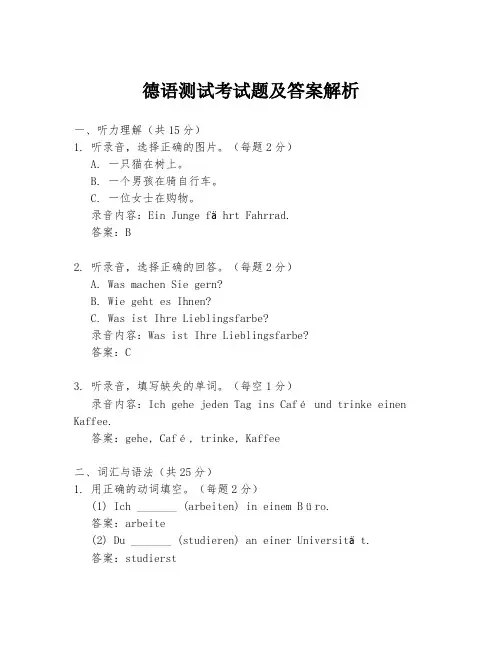
德语测试考试题及答案解析一、听力理解(共15分)1. 听录音,选择正确的图片。
(每题2分)A. 一只猫在树上。
B. 一个男孩在骑自行车。
C. 一位女士在购物。
录音内容:Ein Junge fährt Fahrrad.答案:B2. 听录音,选择正确的回答。
(每题2分)A. Was machen Sie gern?B. Wie geht es Ihnen?C. Was ist Ihre Lieblingsfarbe?录音内容:Was ist Ihre Lieblingsfarbe?答案:C3. 听录音,填写缺失的单词。
(每空1分)录音内容:Ich gehe jeden Tag ins Café und trinke einen Kaffee.答案:gehe, Café, trinke, Kaffee二、词汇与语法(共25分)1. 用正确的动词填空。
(每题2分)(1) Ich _______ (arbeiten) in einem Büro.答案:arbeite(2) Du _______ (studieren) an einer Universität.答案:studierst2. 将下列句子翻译成德语。
(每题3分)(1) 我昨天去了图书馆。
答案:Ich bin gestern in die Bibliothek gegangen.(2) 她正在家里做饭。
答案:Sie kocht gerade zu Hause.三、阅读理解(共30分)阅读以下短文,回答问题。
Es ist ein schöner Tag. Peter und Maria sind im Park. Sie spielen Tennis. Maria hat einen Ball verloren. Peter hilftihr, den Ball zu finden.1. Was machen Peter und Maria?(3分)答案:Sie spielen Tennis.2. Was ist passiert?(3分)答案:Maria hat einen Ball verloren.3. Was tut Peter?(3分)答案:Peter hilft ihr, den Ball zu finden.四、写作(共30分)1. 写一篇短文,描述你上个周末的活动。
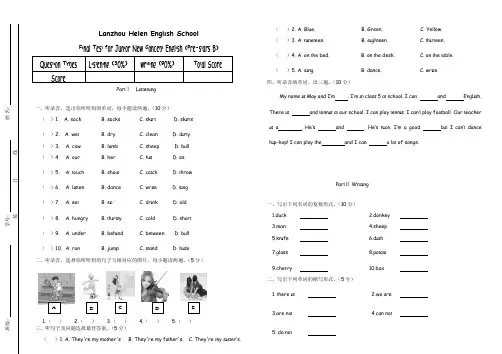
Lanzhou Helen Engl i sh School一、听录音,选出你所听到的单词,每小题读两遍。
(10分)()1. A. sock B. socks C. sk i r t D. sk i r t s()2. A. we t B. dry C. clean D. d i r t y()3. A. cow B. lamb C. sheep D. bull()4. A. our B. her C. h i s D. i t s()5. A. t ouch B. shou t C. ca t ch D. t hrow()6. A. l i s t en B. dance C. wr i t e D. s i ng()7. A. ea t B. s i t C. dr i nk D. old()8. A. hungry B. t h i rs t y C. cold D. shor t()9. A. under B. beh i nd C. be t ween D. bull()10. A. run B. jump C. s t and D. h i de二、听录音,选择你所听到的句子与相对应的图片,每小题读两遍。
(5分)1.()2.()3.()4.()5.()三、听句子及问题选择最佳答案。
(5分)()1. A. They're my mo t her's B. They're my fa t her's. C. They're my s i s t er’s.()2. A. Blue. B. Green. C. Yellow.()3. A. n i ne t een. B. e i gh t een. C. t h i r t een.()4. A. on t he bed. B. on t he desk. C. on t he t able.()5. A. s i ng. B. dance. C. wr i t e.四、听录音填单词,读三遍。
德语测试考试题及答案一、选择题(每题2分,共20分)1. 德语中“图书馆”怎么说?A. BücherregalB. BücherladenC. BüchereiD. Bücherhalle答案:C2. 下列哪个词是“学习”的德语表达?A. spielenB. lernenC. arbeitenD. singen答案:B3. 用德语表达“我很好”应该用哪个句子?A. Ich bin gut.B. Ich bin sehr gut.C. Mir geht es gut.D. Mir geht es sehr gut.答案:C4. 德语中“谢谢”怎么说?A. bitteB. dankeC. entschuldigungD. hallo答案:B5. 以下哪个词不是颜色?A. rotB. blauC. weissD. schnell答案:D6. 德语中“你叫什么名字?”怎么说?A. Wie heißen Sie?B. Wie heiß du?C. Wie heißt du?D. Wie heißen Sie?答案:C7. 下列哪个词是“书”的复数形式?A. BücherB. BuchC. BuchesD. Buchern答案:A8. 德语中“明天”怎么说?A. morgenB. gesternC. heuteD. übermorgen答案:A9. 用德语表达“我喜欢音乐”应该用哪个句子?A. Ich mag Musik.B. Ich hasse Musik.C. Ich liebe Musik.D. Ich mag keine Musik.答案:A10. 德语中“再见”怎么说?A. auf WiedersehenB. halloC. guten TagD. entschuldigung答案:A二、填空题(每题2分,共20分)11. 德语中“我”是__________。
上海紧缺人才培训工程“小语种”(非英语语种)项目德语《岗位资格证书》(B级)考试2008年8月24日笔试试卷(B)卷第一部分听力一、填空(每小题1分,共10题,共10分。
)将听到的内容填写在相应的空格内,文章将播放2遍。
WasserverschmutzungIn der Bundesrepublik Deutschland (1)jedes Jahr 500 kg Abfälle pro Person in das Wassernetz. Der größere Teil stammt aus Industrie und (2). Jedes Jahr wächst diese (3)um (4). Die Flüsse und das Grundwasser nehmen der (5)den Transport ab und (6)daran. Viele Gewässer sind schon (7). In manchen Flüssen gibt es keine Fische mehr und auch kaum noch Mikroorganismen. Der Rhein zum Beispiel (8)große Menge von Schwermetallen, krebserzeugenden (9)und Salzen. Viele dieser Stoffe sind eine Gefahr für die (10)der Bevölkerung, die am Rhein wohnt.二、单项选择(每小题1分,共10题,共10分。
)根据录音中的内容,从4个选项中选择一个正确答案填写在空格内,文章将播放2遍。
1. Wohin möchte die Frau jetzt gehen?a) Zur Schule b) Nach Hausec) Zum Arzt d) Zur Arbeit.2. Wo könnte dieser Dialog stattfinden?a) Im Büro b) Zu Hausec) Im Restaurant d) In einer Telefonzelle3. Welche Folgerung kann man aus der Antwort dieser Frau ziehen?a) Sie möchte eigentlich nicht mitgehen.b) Sie möchte sehr gerne mitgehen.c) Sie möchte lieber essen gehen.d) Sie möchte lieber ins Kino gehen.4. Wann wird der nächste Bus nach Freiburg fahren?a) Um zehn Uhr b) Um halb zehnc) Um halb elf d) Um elf Uhr5. Was wissen Sie über den Mann aus dem Dialog?a) Er meint, dass diese Frau eine Fremde ist.b) Er will dieser Frau nicht antworten.c) Er kennt den Weg zum Bahnhof auch nicht.d) Er möchte den Polizisten fragen.6. Warum entschuldigt sich dieser Mann?a) Er hat das Wörterbuch verloren.b) Er möchte das Wörterbuch nicht mitbringen.c) Er hat vergessen, ihr das Wörterbuch mitzubringend) Er möchte das Wörterbuch noch benutzen.7. Warum kann Inge die Kinder nicht betreuen?a) Sie will zum Kaufhaus fahrenb) Sie ist zu müde.c) Sie will einen Studenten Englisch lehren.d) Sie will zum Englisch lernen gehen.8. Wann kann Frau Schmidt Frau Müller treffen?a) Um 7.00 b) Um 6.00c) Um 6.15 d) Um 6.459. Wie oft geht Herr Schmidt gewöhnlich zum Club?a) Er geht gewöhnlich einmal in der Woche zum Club.b) Er geht gewöhnlich zweimal in der Woche zum Club.c) Er geht gewöhnlich dreimal in der Woche zum Club.d) Er geht täglich zum Club außer Montag.10. Was erfahren wir aus diesem Text?a) Das Zimmer für eine Person kostet mehr als für zwei Personenb) Wenn zwei Personen in dem Zimmer wohnen, wird die Miete verdoppelt.c) Wenn zwei Personen in dem Zimmer wohnen, bezahlt jeder 60 Euro mehr.d) Wenn zwei Personen in dem Zimmer wohnen, muss man 60 Euro mehrbezahlen.第二部分语法词汇三、填空(每小题0.5分,共20题,共10分。
2012-2013学年第一学期《》期末考试试卷(A卷)--1 同济大学浙江学院课程考核试卷(B卷)
2012——2013学年第一学期 命题教师签名: 审核教师签名: 课名:德语二外 考试考查:考试 此卷选为:期中考试( )期终考试( √ )补考( )重修( ) 年级 专业 学号________姓名___________任课教师 李建民 得分 (注意:本试卷共 9 大题, 4 大张,满分100分.考试时间为120分钟。)
1. Was hören Sie zuerst? Kreuzen Sie an! (请在先听到的单词后“□”中打叉) (10 P)
1) volle □ 2) Rand □ 3) Holle □ 4) Kirche □ 5) Kellner □ Wolle □ Land □ Hölle □ Kirsche □ Kölner □
6) Tochter □ 7) Schwein □ 8) Pfaul □ 9) Tier □ 10) Faser □ Töchter □ Schrei □ faul □ Tür □ Vase □
2. Diktat(听写)(13 P) a) Wörter und Wortgruppe(单词和词组)
1. 6. 2. 7. 3. 8. 4. 9. 5.
b) Sätze (句子) 1. 2. 3. 4.
3. Hörverstehen (听力理解) Hören Sie das Lied zweimal und ergänzen Sie! (听两遍,并根据听到的歌词填空)
A: Ich eine Schwestwer. Sie heißt .
B: Ich habe Bruder. Peter ist sein . Zusammen: Das ist Familie. C: Daniels heißt Susanne. Miriams Bruder , wie Sein Name?
D: Ich habe Geschwister. Ich allein. habe viele Tiere in meiner Familie. Meerschweinchen (荷兰猪), kleine Kätzchen (小猫), Wellensittiche (鹦鹉), Hund, einen Fisch (鱼), und eine große in meiner Familie. Ein Meerschweinchen, zwei kleine Kätzchen, drei Wellensittiche, einen , einen und eine große Katze in meiner Familie. 2012-2013学年第一学期《》期末考试试卷(A卷)--2 4. Ergänzen Sie den richtigen Artikel und die richtige Pluralform! (请填入冠词和复数形式)(10 P) Beispiel:(例如) der Student -en
1) _____ Speisekarte _______ 2) _____Saft _______ 3) _____ Frühstück______ 4) _____ Universität _______ 5) _____ Bild _______ 6) _____ Wunsch _______ 7) _____ Lehrerin _______ 8) _____Stadt _______ 9) _____ Gast _______ 10) _____ Bruder _______
5. Ergänzen Sie die Präposition, wenn es nötig ist, auch Artikel! (请填入介词,如有必要,同时填入定冠词)(10 P)
1) Woher kommen Sie? -Ich komme ____________ China. 2) ____________ dem Unterricht gehe ich ____________ Hause. 3) Gehen die Studenten oft ____________ Lehrerin? 4) Hilft dir deine Freundin ____________ Lernen? 5) Ich danke dir ____________ deine Hilfe. 6) Antworte mir bitte____________ die Frage! 7) Wir haben keine Angst ____________ der Prüfung 8) Erika studiert Chinesisch Tongji-Universität. 9) Im Restaurant nimmt Hans Schnitzel Pommes Frites.
6. Ergänzen Sie das Verb!(请填入动词的恰当形式)(10 P) 1) Peter ____________ Thomas zum Abendessen . (einladen)
2) Der Vater ____________ es dem Kind. (geben) 3) ____________ du abends auch ____________? (fernsehen) 4) ____________ ihr aus Beijing? (sein) 5) ____________ Li Hong Fleisch oder Fisch? (essen) 6) ____________ du Li Ming? (heißen) 7) Was ____________ deine Mutter ? (vorhaben) 8) Er ____________ in der Chemiefabrik. (arbeiten) 9) ____________ die Ärztin Deutsch? (sprechen) 10) Ich laufe langsam. Aber er ____________ schnell. (laufen)
7. Ergänzen Sie!(请用括号内单词的恰当形式填空)(10 P) 1) Das macht ____________ bestimmt Freude. (ihr) 2) Li Ming begrüßt ____________. (ich) 3) Ich wünsche ____________ alles Gute. (sie) 4) Sie bringt ein Geschenk mit. (ihr Lehrer) 5) Frau Li holt für ____________ eine Gabel und ein Messer. (er) 6) Der Fisch schmeckt ____________ sehr gut. (wir) 7) Der Student dankt ____________ für seine Hilfe. (es) 2012-2013学年第一学期《》期末考试试卷(A卷)--3 8) Er besucht . (ein Student) 9) Robert und Hans wohnen bei . (ihre Eltern) 10) Ich gratuliere ____________ herzlich zum Geburtstag.(Sie)
8. Übersetzen Sie bitte!(翻译)(10 P) 1) 我母亲明天过生日,我们要办一个派对(聚会)。
2) 她每天7点半吃早餐,8点钟去上课。 3) 你快来吧!我们时间不多了。—— 好,我这就来。
4) 我们都不吸烟。请你们也别吸烟!
5) 在德国人们晚上有时吃热餐,有时吃冷餐。 9. Lesen und Verstehen (阅读理解)(10 P) Lesen Sie den Text und machen Sie dann die Aufgabe!
Wie lernt man schnell und besonders gut Deutsch? Xiaomei ist meine Freundin. Sie studiert seit einem Jahr in Deutschland. Aber Xiaomei spricht noch nicht gut Deutsch. Eines Tages trifft sie auf dem Weg zur Uni(在去大学的路上) ihren Mitschüler, Hanhan. Der studiert auch seit einem Jahr in Deutschland, aber er kann schon sehr gut Deutsch sprechen. So fragt Xiaomei ihren Mitschüler um Rat.
Xiaomei: Ah, Hanhan, kannst du mir einen guten Rat geben? Wie lernt man schnell und besonders gut Deutsch?
Hanhan: Ja, weißt du, - ich möchte Deutschlehrer werden! Nun, ich bin oft mit meinen deutschen Freunden zusammen und spreche mit ihnen über alles mögliche, z. B. über unsere Familie, über Bücher, über China und Deutschland. Ich komme möglichst wenig mit meinen chinesischen Freunden zusammen.
Xiaomei: Wirklich? Das ist aber schwer für mich. Ich denke oft an meine Eltern und meine Freunde in China. Ich bin oft mit meinen chinesischen Freunden zusammen. Das ist doch natürlich.